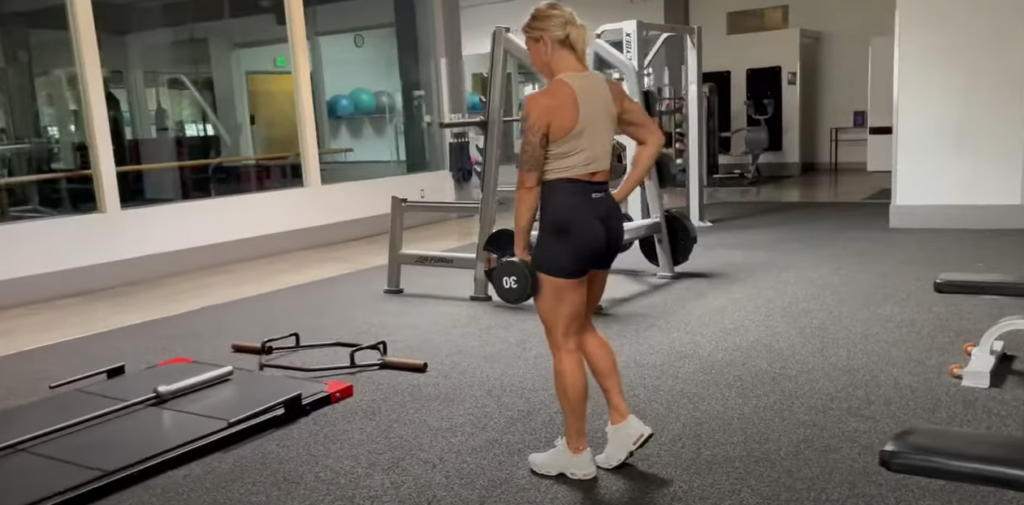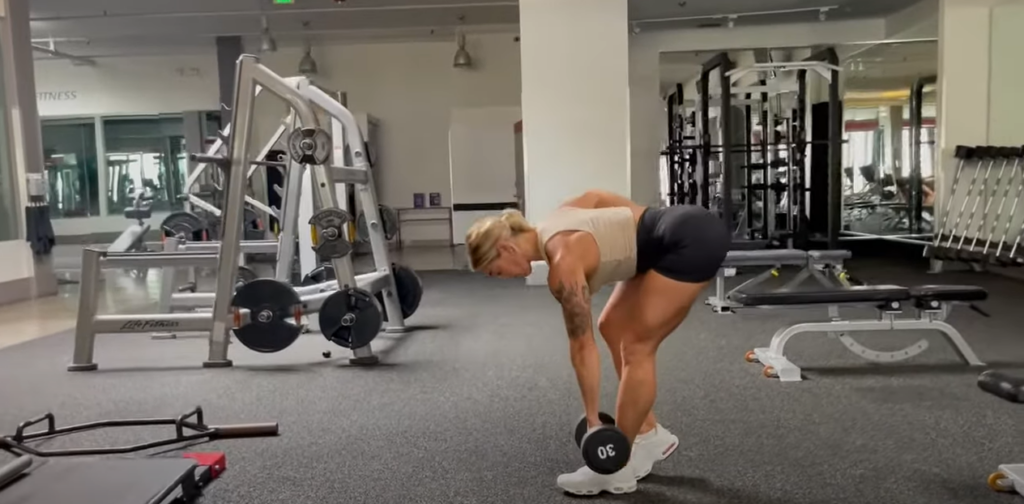The B-Stance Romanian Deadlift (RDL) is an advanced variation of the traditional Romanian Deadlift that offers a challenging and effective way to target the hamstrings, glutes, and lower back while promoting stability and balance. In this comprehensive guide, we will delve into the mechanics of the B-Stance RDL, its benefits, detailed step-by-step instructions, common mistakes to avoid, programming recommendations, and frequently asked questions.
Understanding the B-Stance Romanian Deadlift
The B-Stance RDL is a unilateral exercise that requires you to stand with one foot slightly behind and to the side of the other foot while performing the Romanian Deadlift movement. This unique stance creates a “B” shape, which adds an element of instability and activates stabilizing muscles, making it an excellent option for advanced lifters seeking to improve strength and balance.
Benefits of the B-Stance RDL
- Targeted Muscle Engagement: The B-Stance RDL places significant emphasis on the hamstrings, glutes, and lower back, helping to develop strength and muscle definition in these areas;
- Stability and Balance: The asymmetrical foot positioning challenges your balance, requiring your core and stabilizer muscles to work harder to maintain proper form;
- Unilateral Strength Development: By training one leg at a time, the B-Stance RDL helps identify and address muscle imbalances, reducing the risk of injury and improving overall functional strength;
- Injury Prevention: Strengthening the posterior chain through the B-Stance RDL can lead to improved stability in the lower back and hips, reducing the likelihood of injury during daily activities and sports;
- Functional Movement: The B-Stance RDL replicates movements encountered in sports and daily life, making it a valuable exercise for functional strength development.
Proper Technique

Executing the B-Stance RDL with proper form is essential to maximize its benefits and minimize the risk of injury. Follow these step-by-step instructions:
Equipment
Here’s what you’ll need for the B-Stance RDL:
| Equipment | Description |
|---|---|
| Barbell/Dumbbells | Based on your preference |
| Weight Plates | Appropriate for your strength level |
| Lifting Platform | Or any stable surface to perform the exercise on |
Step 1: Starting Position
- Feet Placement: Begin by standing tall with your feet shoulder-width apart;
- B-Stance Formation: Position your dominant foot (usually the stronger one) in the center, and the other foot slightly behind and to the side at a comfortable angle, forming the “B” shape.
Step 2: Hand and Posture Alignment
- Grip: Hold the barbell or dumbbells in front of your thighs with a pronated (overhand) grip;
- Posture: Maintain a neutral spine, engage your core, and keep your shoulders pulled back and down throughout the movement.
Step 3: The Descent
- Hip Hinge: Initiate the descent by hinging at the hips, pushing your glutes back while slightly bending your knees;
- Lowering the Weights: Lower the weights towards the floor, keeping them close to your body;
- Balance with Non-Dominant Foot: Allow your non-dominant foot to lift slightly off the ground while keeping it in contact with the floor for balance.
Step 4: The Stretch
- Feeling the Stretch: Lower the weights until you feel a stretch in your hamstrings without rounding your back excessively.
Step 5: The Ascent
- Pause: Pause briefly at the bottom position;
- Return to Starting Position: Return to the starting position by engaging your glutes and hamstrings.
Key Tips and Safety Considerations
- Always Warm Up: Ensure that you warm up properly before attempting this exercise;
- Weight Selection: Choose a weight that is challenging but allows you to perform the exercise with proper form;
- Avoid Hyperextension: Do not hyperextend your back at the top of the movement;
- Breathing Technique: Inhale during the descent and exhale as you return to the starting position.
Common Mistakes to Avoid

Even though the B-Stance RDL can be highly effective, performing it incorrectly may lead to suboptimal results or injury. Avoid the following common mistakes:
1. Rounded Back
A rounded back during the B-Stance RDL can create unnecessary strain on the spinal column. Here’s what you need to know:
- Correct Posture: Maintain a neutral spine;
- Why it Matters: A rounded back alters the natural curvature of the spine, leading to potential discomfort or injury;
- How to Correct: Focus on keeping your chest up and shoulders back. Engage your lats and imagine pulling your shoulder blades together.
Rounded Back Correction
| Action | Description |
|---|---|
| Neutral Spine | Align your spine in its natural curve without over-arching. |
| Engage Lats | Activate the muscles in your back to support your spine. |
| Chest Up | Focus on lifting your chest, keeping your upper back engaged. |
2. Knee Bending
Bending your knees excessively.
- Target Muscles: The B-Stance RDL targets the hamstrings and glutes;
- Common Mistake: Excessive knee bending shifts the focus to the quadriceps;
- Correction Method: Maintain a slight bend in the knees to keep the emphasis on the hamstrings and glutes.
3. Incorrect Foot Placement
- What is the B-Stance?: Your non-dominant foot is positioned behind and to the side at a comfortable angle, creating the “B” stance;
- Mistake: Placing the foot incorrectly alters the stability and effectiveness of the exercise;
- How to Correct: Ensure your foot is aligned correctly, with toes pointing slightly outwards and heel off the ground.
Proper Foot Placement in B-Stance RDL
| Placement | Description |
|---|---|
| Behind & Side | Non-dominant foot positioned at a comfortable angle |
| Toes Pointing Out | Helps in maintaining balance |
| Heel Off the Ground | Ensures proper engagement of the target muscles |
4. Poor Core Engagement
- Why Core Engagement Matters: Engaging your core stabilizes the entire body during the exercise;
- Common Mistake: Lack of core engagement can compromise your stability;
- How to Correct: Keep your core tight throughout the movement.
Programming the B-Stance RDL
Incorporating the B-Stance RDL into your training program requires strategic planning to optimize its benefits. Below is a sample eight-week program to integrate the exercise into your routine:
| Week | Training Frequency | Sets x Repetitions | Rest Between Sets |
|---|---|---|---|
| Week 1-2 | 2 times per week | 3 x 10 each leg | 60 seconds |
| Week 3-4 | 2 times per week | 4 x 8 each leg | 60 seconds |
| Week 5-6 | 3 times per week | 4 x 6 each leg | 45 seconds |
| Week 7-8 | 3 times per week | 5 x 5 each leg | 45 second |
Conclusion
The B-Stance Romanian Deadlift is a dynamic exercise that offers an effective means of targeting the hamstrings, glutes, and lower back while promoting stability and balance. By mastering the proper technique and incorporating it into a well-structured training program, you can experience the numerous benefits it has to offer. Remember that patience and consistency are essential when undertaking advanced exercises like the B-Stance RDL. Always prioritize safety, and if you have any concerns or limitations, seek advice from a qualified fitness professional or healthcare provider.
FAQ
While the B-Stance RDL is an advanced variation, beginners can attempt it. However, it’s essential to start with light weights and focus on perfecting the technique before increasing the resistance.
Yes, you can perform the B-Stance RDL with either dumbbells or a barbell. Dumbbells offer a more natural range of motion and are particularly useful if you have one side weaker than the other.
For optimal results, aim to incorporate the B-Stance RDL 2-3 times per week into your strength training routine. Remember to allow adequate rest between sessions to facilitate muscle recovery.
The B-Stance RDL can help strengthen the muscles in the lower back and hips, potentially reducing the risk of lower back pain. However, if you have existing lower back issues, it’s essential to consult with a healthcare professional before starting any new exercise program.
You can progress the B-Stance RDL by gradually increasing the resistance (weight) or the number of sets and reps. Additionally, you can try performing the exercise on an unstable surface, like a balance pad, to further challenge your stability and balance.
